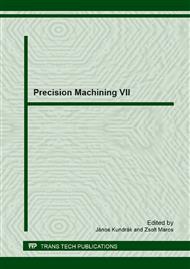[1]
F.A. Almeida, A.J.S. Fernandes, F.J. Oliveira, R.F. Silva, Semi-orthogonal turning of hardmetal with CVD diamond and PCD inserts at different cutting angles, Vacumm 83 (2009) 1218-1223.
DOI: 10.1016/j.vacuum.2009.03.029
Google Scholar
[2]
T. Miyamoto, J. Fujiwara, K. Wakao, Influence of WC and Co in Cutting Cemented Carbides with PCD and CBN Tools, Key Engineering Materials 407 (2009) 428-431.
DOI: 10.4028/www.scientific.net/kem.407-408.428
Google Scholar
[3]
L. Jaworska, Diament: otrzymywanie i zastosowanie w obróbce skrawania, WNT, Warszawa, (2007).
Google Scholar
[4]
L.A. Dobrzański, Podstawy nauki o materiałach i metaloznawstwo: Materiały inżynierskie z podstawami projektowania materiałowego, WNT, Warszawa, 2002, pp.878-910.
Google Scholar
[5]
M. Belmonte, P. Ferro, A.J.S. Fernandes, F.M. Costa, J. Sacramento, R.F. Silva, Wear resistant CVD diamond tools for turning of sintered hard metals, Diamond and Related Materials 12 (2003) 738-743.
DOI: 10.1016/s0925-9635(02)00302-3
Google Scholar
[6]
Information on http: /www. mitsubishicarbide. com.
Google Scholar
[7]
H. Tanaka, S. Shimada, N. Ikawa, M. Yoshinaga, Wear Mechanism of Diamond Cutting Tool in Machining of Steel, Key Engineering Materials 196 (2001) 69-78.
DOI: 10.4028/www.scientific.net/kem.196.69
Google Scholar
[8]
M. Belmonte, P. Ferro, A.J.S. Fernandes, F.M. Costa, J. Sacramento, R.F. Silva, Cutting forces evaluation with tool wear in sintered hard metal turning with CVD diamond, Diamond and Related Materials 13 (2004) 843-847.
DOI: 10.1016/j.diamond.2003.11.018
Google Scholar
[9]
S. Heo, Micro cutting of tungsten carbides with SEM direct observation method, KSME International Journal 18 (2004) 770-779.
DOI: 10.1007/bf02990295
Google Scholar
[10]
S. Heo, Environmentally conscious hard turning of cemented carbide materials on the basis of micro-cutting in SEM: stressing four kinds of cemented carbides with PCD tools, J. Mechanical Science and Technology 22 (2008) 1383-1390.
DOI: 10.1007/s12206-008-0411-z
Google Scholar
[11]
W. Zębala, R. Kowalczyk, Research of sintered carbide turning with a PCD tool, presented at the XXVII microCAD International Scientific Conference University of Miskolc.
Google Scholar
[12]
C.W. Xiao, H. Ding, W.D. Li, K. Cheng, Design and Analysis of a Novel Sensing Cutting Tool for Precision Turning, Key Engineering Materials 516 (2012) 373-377.
DOI: 10.4028/www.scientific.net/kem.516.373
Google Scholar
[13]
R.K. Roy, Design of Experiment Using Taguchi Approach: 16-step approach for applying the Taguchi method, John Wiley & Sons, (2001).
Google Scholar
[14]
Information on http: /my. fit. edu.
Google Scholar
[15]
U. Esme, Application of Taguchi method for the optimization of resistance spot welding process, The Arabian Journal for Science and Engineering 34 (2009) 519-522.
Google Scholar
[16]
Y.P. Ballal, K.H. Inamdar, P.V. Patil, Application of Taguchi method for design of experiments in turning gray cast iron, IJERA 2 (2012) 1391-1397.
Google Scholar
[17]
R. Unal, E.B. Dean, B. Edwin, Taguchi Approach to design optimization for quality and cost: an overview, presented at the Annual Conference of the International Society of Parametric Analysts (1991).
Google Scholar
[18]
I.M. Dagawa, Surface Roughness Optimization of Some Machining Parameters in Turning operations using Taguchi Method, Advanced Materials Research 62-64 (2009) 613-620.
DOI: 10.4028/www.scientific.net/amr.62-64.613
Google Scholar
[19]
N. Muthukrishnan, J.P. Davim, Optimization of machining parameters of Al/SiC-MMC with ANOVA and ANN analysis, J. Materials Processing Technology 1 (2009) 225-232.
DOI: 10.1016/j.jmatprotec.2008.01.041
Google Scholar
[20]
Z. Xueping, G. Erwei, C.R. Liu, Optimization of process parameter of residual stresses for hard turned surfaces, J. Materials Processing Technology 9 (2009) 4286-4291.
DOI: 10.1016/j.jmatprotec.2008.10.011
Google Scholar
[21]
J. Verma, P. Agrawal, L. Bajpai, Turning parameter optimization for surface roughness of ASTM A242 type-1 alloys steel by Taguchi method, IJAET 3 (2012) 255-261.
Google Scholar


